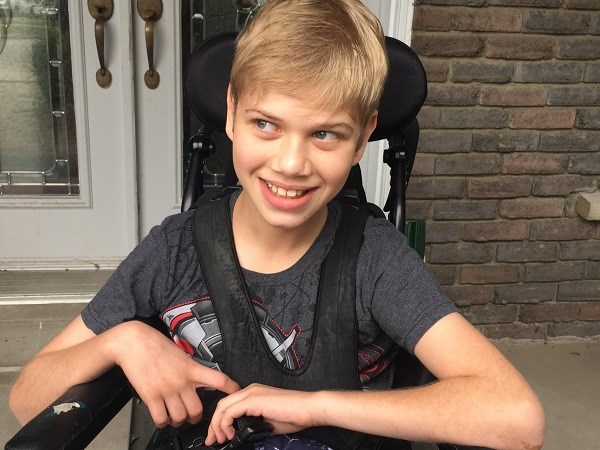Unravelling the mystery of rare diseases
Summary:
When Bryson Williams-McArthur was 9, he underwent whole exome sequencing at SickKids, a sophisticated, non-targeted approach to genetic testing that takes a broad look at all 20,000 genes. This test finally gave the family a diagnosis – a very rare neurodevelopmental disorder called GRIN1.
Bryson Williams-McArthur, 13, is the younger of Laura Williams’ and Keith McArthur’s two sons. Bryson appeared to be healthy at birth, but as the months went by he missed milestones for sitting, crawling, talking and walking and had low muscle tone and other worrying symptoms. Despite numerous MRIs and EEGs, blood and genetic tests, a muscle biopsy, and a great deal of waiting for results, no one was able to tell the family specifically what their child’s condition was.
Whole exome sequencing allows for a rare diagnosis
When Bryson was 9, he underwent whole exome sequencing at SickKids, a sophisticated, non-targeted approach to genetic testing that takes a broad look at all 20,000 genes. This test finally gave the family a diagnosis – a very rare neurodevelopmental disorder called GRIN1.
There is no treatment for Bryson’s condition, but having a diagnosis has made a crucial difference to the Williams-McArthur family. They say it’s given them hope as well as a sense of community with other families affected by GRIN1 around the world. They can also focus on something other than finding a diagnosis.

Today, Bryson faces many challenges, but he’s a happy, social boy who laughs at funny sounds and slapstick. He attends school every day and enjoys going to Blue Jays games and watching them on TV. He needs help piloting his wheelchair, but he can move around quickly in his walker when he wants to. He also loves playing with his younger cousins who climb up onto his lap in the wheelchair. According to dad, Keith, he gives great hugs.
Since the diagnosis, the family’s focus has turned toward telling Bryson’s story and searching for a cure for his disease. Keith and Laura have met with a number of genetics specialists in Canada (including his clinical team at SickKids) and in the US who are using the latest cutting-edge technologies to uncover the complexities of GRIN1.
Rare Disease Day annual event at SickKids fosters collaboration
On Friday, February 28, the annual Rare Disease Day event was held at SickKids, bringing together clinicians, researchers and patient families to share information and experiences and to foster and enrich collaborations.
This year's theme was "Advancing diagnosis and treatment for neurogenetic disorders." The event was presented by SickKids, the Rare Disease Foundation, Can-Gard and SickKids Foundation.
Dr. Ronald Cohn, President and CEO of SickKids, opened the event with a story about an email he got more than a decade ago from a Toronto mother asking for help to find a diagnosis for her infant son with a developmental delay and low muscle tone.
At the time, Cohn was working as a geneticist at Johns Hopkins University in Baltimore. The woman who emailed him was Bryson’s mother, Laura. The two kept in touch by email over the years and, in what seemed like a very lucky coincidence, Cohn eventually moved from Johns Hopkins to SickKids and became Bryson’s genetics specialist.
It was Cohn and the SickKids Clinical & Metabolic Genetics team who diagnosed Bryson with GRIN1 four years ago.
Continuing throughout the day, experts from across the Hospital and Research Institute and other institutions spoke about the latest research, diagnostics and therapeutics for rare diseases such as Huntington’s and Spinal Muscular Atrophy.
During the networking and poster sessions, trainees showcased some of the groundbreaking research being conducted in SickKids labs. Parents spoke about their experiences and the impact of rare disease on their lives.
Among the families attending were Keith, Laura, Bryson and his older brother Connor, 16. They gave a presentation called "Searching for a Cure: A Rare Disease Journey."
"It feels like we're at this point in time where many diseases we thought of as incurable could find cures over the next 10 to 20 years. We want to do whatever we can to help kids with GRIN1 disorder. It was such an honour to share our story with other rare disease families at SickKids," Keith said.
Dr. Monica Justice, Program Head & Senior Scientist in the Genetics & Genome Biology program at SickKids, and Dr. Neal Sondheimer, Interim Head of the Division of Clinical & Metabolic Genetics at SickKids, were the event’s masters of ceremonies.
Dr. A. Micheil Innes, Professor in the Departments of Pediatrics and Medical Genetics at the Cumming School of Medicine at the University of Calgary, kicked off the day's events with trainees and gave the keynote presentation about rare diseases in Canada’s Hutterite population.
“The study of rare disease impacts our knowledge of common diseases that include diabetes, autism and cancer, providing avenues for improving quality of life for patients and their families. Now is the time to raise awareness of rare diseases and bring them to the forefront of diagnosis, research and treatment.”

